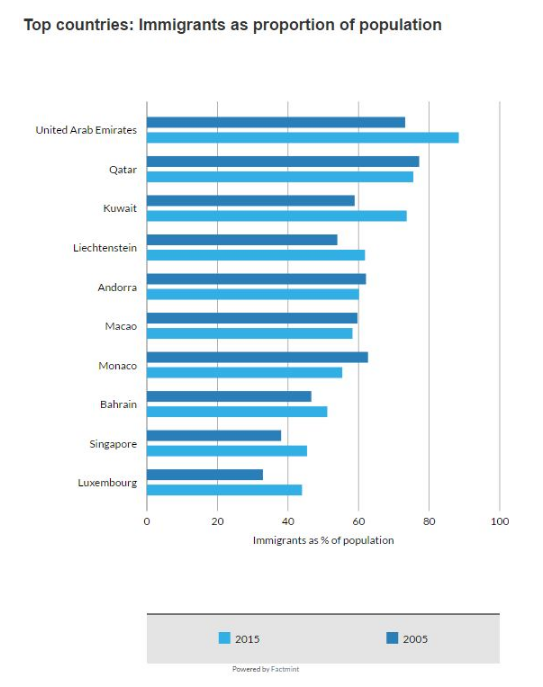Which countries have the most immigrants?

Europe is a long way away from being the primary destination for people leaving their homelands in search of a better life
Image: REUTERS/Ahmed Jadallah
Stay up to date:
Migration
One of the biggest mass movements of people in recent history continues to dominate news headlines and political discourse.
The defining images of the refugee crisis have been those showing hundreds of flimsy boats arriving on the beaches of southern Europe. Each one disembarks a human cargo of desperate and frightened people with a turbulent past and an uncertain future.

The political reaction to the crisis has been mixed. Germany, at least initially, warmly welcomed the new arrivals. In Britain, concern over immigration played a major role in the vote to leave the European Union. Anti-immigration sentiment is also expected to play a significant role in upcoming elections in France, Germany and the Netherlands.
But while immigration into Europe has so far dominated this narrative, Europe is a long way away from being the primary destination for people leaving their homelands in search of a better life.
Immigration - a broader perspective
Britain’s Daily Telegraph has taken a wider view of immigration. The paper analyzed UN figures to calculate which countries have the most immigrants per head of population.
Using this metric, the United Arab Emirates tops the ranking. A full 88% of its population were born in another country. It’s important to note that the vast majority of immigrants in the UAE are economic migrants, not refugees.

According to figures from the Migration Policy Institute, almost 3.5m of migrants in the UAE are from India, 935,000 are from Egypt, and 906,000 from Pakistan. The majority work in low-skilled occupations. Migrant workers in the UAE have no right to remain permanently. Their visas are tied to contracts with their employers. Once those contracts are terminated they must leave the UAE.

Second on the Telegraph’s list is Qatar. More than 75% of its population is foreign-born. Indians are the biggest group of immigrants, numbering 646,000. People from Egypt and Bangladesh form the next largest groups with 164,000 and 160,000 respectively. Hundreds of thousands of migrants are working to build the infrastructure for the FIFA World Cup finals that Qatar will host in 2022.
Qatar and other Gulf nations also host significant numbers of migrant workers from western nations. These groups work at more senior levels in mainly white collar roles. Unlike most migrants from south Asia, westerners generally earn high salaries. They also enjoy the epithet ‘expat’ rather than the more pejorative ‘migrant worker.’

Third is Kuwait with 74%. Most of these migrants are from India, Egypt, Pakistan and Bangladesh.

Fourth and Fifth on the list are small European countries Liechtenstein and Andorra. Sandwiched between Austria and Switzerland, Liechtenstein is just 25km long and home to only around 40,000 people. Of those, 62% of are foreign-born, mostly hailing from Switzerland. Sixty percent of Andorra’s population are immigrants, mostly from Spain.
At the other end of the scale, countries in Central and South America are attracting the smallest numbers of migrants.

In Central America just 1.2% of the population are migrants. In El Salvador and Nicaragua, for example, only 0.7% of the population are immigrants. In South America, only 1.4% of people were born outside the continent.
Don't miss any update on this topic
Create a free account and access your personalized content collection with our latest publications and analyses.
License and Republishing
World Economic Forum articles may be republished in accordance with the Creative Commons Attribution-NonCommercial-NoDerivatives 4.0 International Public License, and in accordance with our Terms of Use.
The views expressed in this article are those of the author alone and not the World Economic Forum.
Forum Stories newsletter
Bringing you weekly curated insights and analysis on the global issues that matter.
More on Youth PerspectivesSee all
Kulé Galma
April 15, 2025
Roberta Bosurgi and Ruma Bhargawa
March 7, 2025
Christa Odinga-Svanteson
March 7, 2025
Mario Truss and Benedikt Gieger
February 18, 2025
Julie Linn Teigland
January 23, 2025





